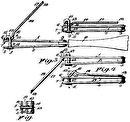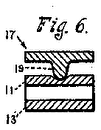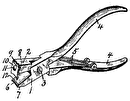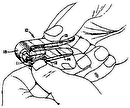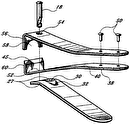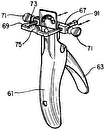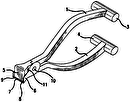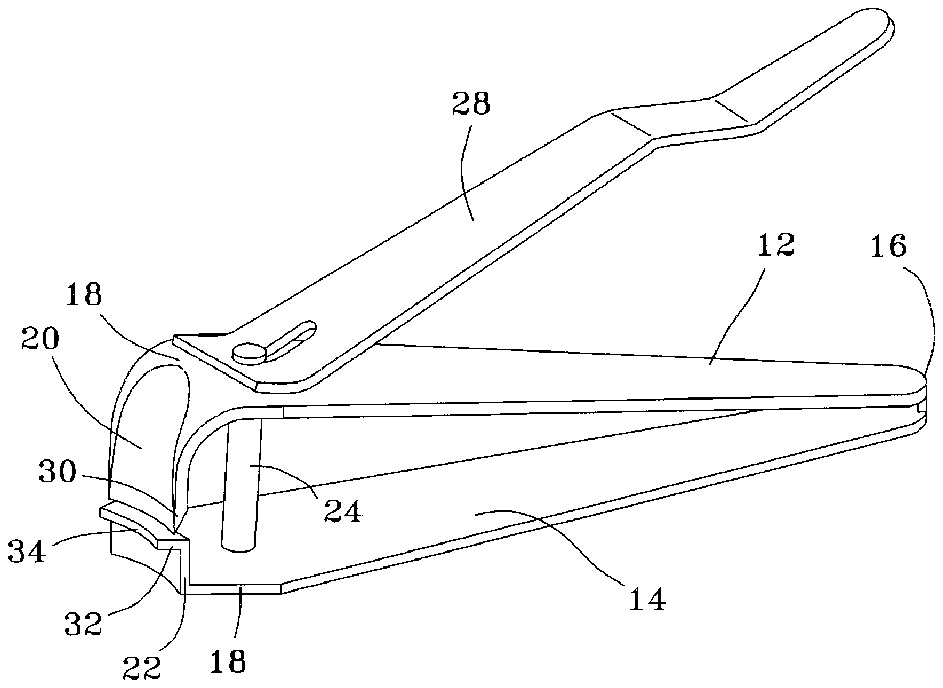
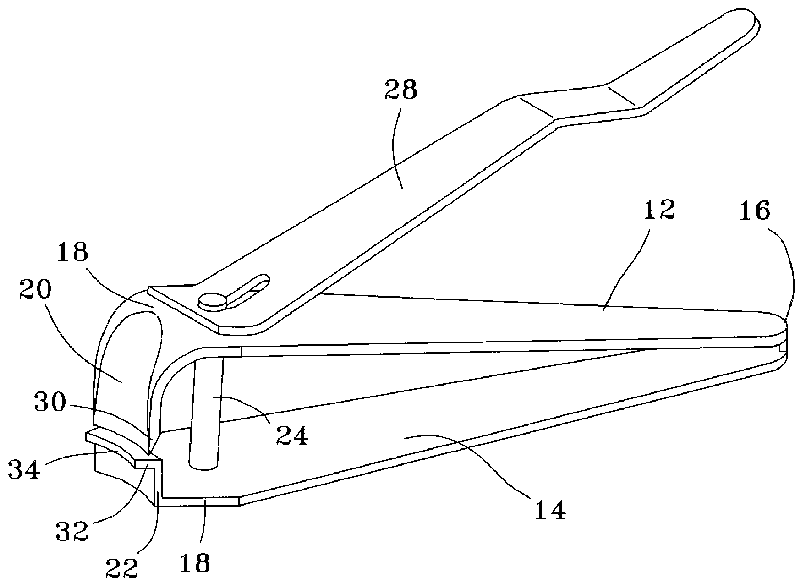
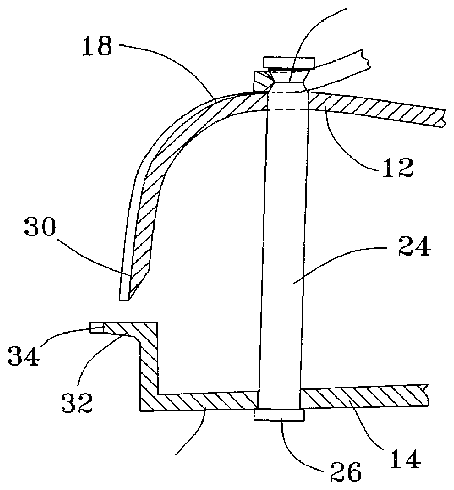
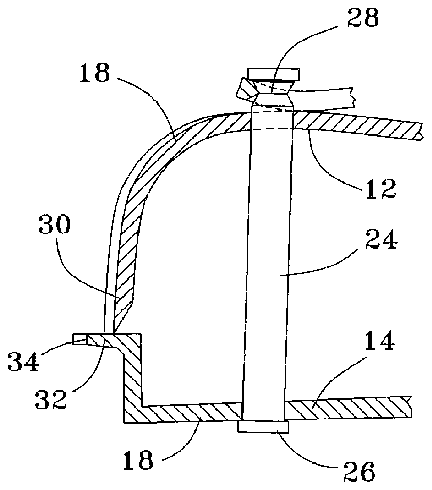
- 10clipper
- 12arms
- 14second arm
- 16first ends
- 18second ends
- 20jaws
- 22jaw
- 24post
- 26head
- 28lever
- 30blade
- 32plate
- 34distal edge
Abstract
A nail clipper whose jaws are configured to reduce the risk of clipping the tip of a toe or finger when trimming the nail thereof. The clipper includes first and second jaws, with the second jaw opposing the first jaw and being sufficiently adjacent the first jaw to define a gap therebetween for receiving the nail of a finger or toe. The clipper further includes a feature for pivoting the first and second jaws toward each other. A blade is provided on the first jaw and extends toward the second jaw, and a plate is provided on the second jaw so as to oppose the blade of the first jaw. The plate has a planar surface against which the blade abuts when the first jaw is fully pivoted toward the second jaw by the pivoting feature. As such, only one of the jaws is formed to have a cutting feature (blade), so that the jaws cooperate to cut through a nail from only one side of the nail.
Description
CROSS REFERENCE TO RELATED APPLICATIONS
[0001] This application claims the benefit of U.S. Provisional Application No. 60/721,151, filed Sep. 28, 2005, the contents of which are incorporated herein by reference.
BACKGROUND OF THE INVENTION
[0002] The present invention generally relates to personal care and grooming products, and more particularly to nail clippers configured to reduce the risk of clipping the tips of fingers and toes, particularly those of young children.
[0003] Neatly-trimmed fingernails and toenails are part of a well-groomed appearance and can be beneficial to a person's overall health. Clippers widely used for trimming nails typically comprise a pair of arms that extend side by side, with each arm having a jaw at one end biased apart from the jaw of the other arm to define a gap therebetween. The jaws are forced together, typically with a lever operating on a fulcrum, to generate sufficient force to clip a nail placed between the jaws. Each jaw is formed to have sharp cutting blades in order to simultaneously cut through from opposite sides of the nail. Particularly when clipping fingernails of infants and toddlers, both the nail and tip of the finger or toe beneath the nail can be accidentally placed between the jaws, so that the blades not only cut through the nail but also the finger tip or toe tip.
BRIEF SUMMARY OF THE INVENTION
[0004] The present invention provides a nail clipper whose jaws are configured to reduce the risk of clipping the tips of toes and fingers when trimming fingernails and toenails.
[0005] According to a first aspect of the invention, the nail clipper comprises first and second jaws, with the second jaw opposing the first jaw and being sufficiently adjacent the first jaw to define a gap therebetween for receiving the nail of a finger or toe. The clipper further includes a feature for pivoting the first and second jaws toward each other. A blade is provided on the first jaw and extends toward the second jaw, and a plate is provided on the second jaw so as to oppose the blade of the first jaw. The plate has a planar, noncutting surface against which the blade abuts when the first jaw is fully pivoted toward the second jaw by the pivoting feature. As such, only one of the jaws is formed to have a cutting feature (blade), so that the jaws cooperate to cut through a nail from only one side of the nail.
[0006] In use, the nail of a digit (i.e., finger or toe) is inserted into the gap between the first and second jaws so that the plate is beneath the nail and shields the digit beneath the nail from the blade of the first jaw. The first and second jaws can then be pivoted toward each other until the nail is trimmed as a result of the blade cutting through the nail until the blade abuts the plate.
[0007] In view of the above, it can be seen that the plate shields and thus protects the tip of the finger or toe being trimmed from the blade of the nail clipper, and therefore essentially eliminates the risk of cutting the finger or toe tip while trimming the nail.
[0008] Other objects and advantages of this invention will be better appreciated from the following detailed description.
BRIEF DESCRIPTION OF THE DRAWINGS
[0009] FIG. 1 is a perspective view of a nail trimmer in accordance with a preferred embodiment of this invention.
[0010] FIGS. 2 and 3 represent detailed side views of the nail trimmer of FIG. 1 with the jaws of the trimmer open and closed, respectively.
DETAILED DESCRIPTION OF THE INVENTION
[0011] FIG. 1 illustrates a nail clipper 10 configured to enable the fingernails and toenails of an individual to be safely trimmed with greatly reduced risk of clipping the tips of fingers and toes, particularly those of young children. From FIG. 1 , it can be seen that the nail clipper 10 is generally configured similarly to that of conventional clippers. The clipper 10 can be manufactured in a range of sizes appropriate for use on the fingernails and toenails of adults, children, toddlers, and infants. A variety of materials could be used to form the components of the clipper 10 , including those known and used to manufacture conventional clippers.
[0012] The clipper 10 comprises two arms 12 and 14 that are shown joined at adjacent first ends 16 . As known, the intent of joining the first ends 16 of the arms 12 and 14 is to bias apart oppositely-disposed second ends 18 of the arms 12 and 14 , where first and second jaws 20 and 22 , respectively, are defined. Accordingly, in addition to the joint shown, various other configurations are possible for achieving the biasing effect, including rivets, etc., and such variations are within the scope of this invention. A nail file and other accessories can be attached at the second ends 18 of the arms 12 and 14 as also done with conventional clippers.
[0013] The arms 12 and 14 are coupled adjacent their second ends 18 with a post 24 that extends through both arms 12 and 14 . The post 24 can be secured to the arms 12 and 14 in a conventional manner, such as a head 26 abutting the second arm 14 ( FIGS. 2 and 3 ) and a lever 28 engaging a slot in the opposite end of the post 24 extending from the first arm 12 . The distance between the head 26 and slot in the post 24 is less than the free distance between the arms 12 and 14 where the post 24 is installed, so that when installed on the post 24 the lever 28 forces the arms 12 and 14 a limited distance toward each other, as shown in FIG. 2 . As also conventional, the lever 28 uses the first arm 12 as a fulcrum, so that pivoting the lever 28 toward the first arm 12 further pivots the arms 12 and 14 toward each other until their jaws 20 and 22 engage each other, as shown in FIG. 3 .
[0014] As seen in FIG. 1 and in more detail in FIGS. 2 and 3 , the jaw 20 of the first arm 12 defines a sharp cutting blade 30 that extends toward the jaw 22 of the second arm 14 . As with conventional clippers, FIG. 1 shows the blade 30 as having an arcuate or contoured cross-sectional shape in a plane substantially normal to the blade 30 , corresponding to the trimmed shape typically desired for finger and toe nails. The jaw 22 of the second arm 14 differs from the jaw 20 of the first arm 12 by its lack of a blade or other cutting feature, instead defining a plate 32 that extends from the jaw 22 in a direction substantially normal to the blade 30 . The upper surface of the plate 32 is preferably planar to provide a uniform surface against which the blade 30 abuts when the jaws 20 and 22 are fully pivoted toward each other, as represented in FIG. 3 . The lower edge of the blade 30 is preferably parallel to the upper planar surface of the plate 32 , so that the entire blade 30 abuts the plate 32 when the jaws 20 and 22 are fully pivoted toward each other by the lever 28 .
[0015] From FIG. 3 , it can be seen that the plate 32 extends beyond the blade 30 , defining a lip portion of the plate 32 that lies outside the closed jaws 20 and 22 . The lip portion terminates with a distal edge 34 that preferably has an arcuate shape complementary to the typical contour of the intersection where a fingernail or toenail meets the nail bed on which the nail grows. In this manner, when a nail is placed within the gap seen between the blade 30 and plate 32 in FIG. 2 , the plate 32 can be fully inserted beneath a nail to shield the finger or toe from the blade 30 as the blade 30 is actuated downward against the plate 32 to trim the nail without risk of clipping the tip of the finger or toe. Because only the first jaw 20 is equipped with a blade 30 or other feature capable of cutting a nail, the jaws 20 and 22 cooperate to cut through a nail from only one side of the nail. The lack of a blade on the second jaw 22 is compatible with actuating only the first jaw 20 with the lever 28 , in that the plate 32 of the second jaw 22 is intended to remain completely stationary (abutting the lower surface of the nail) during the trimming operation.
[0016] While the invention has been described in terms of a preferred embodiment, it is apparent that other forms could be adopted by one skilled in the art. For example, the physical configuration of the clipper 10 , arms 12 and 14 , jaws 20 and 22 , etc., could differ from that shown, and yet obtain the safety feature of the plate 32 . Therefore, the scope of the invention is to be limited only by the following claims.
